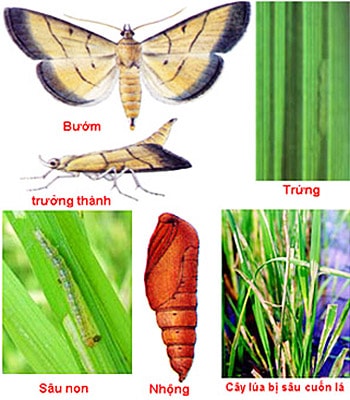Rice leaf roller
The rice leaf roller (Cnaphalocrocis medinalis) is an important pest of rice plants in our country and many other countries in the region.

After hatching, the larvae spin silk along the two edges of the rice leaves to form a bag, then lie inside and eat the green matter of the leaves, leaving only the white membrane on the outside. This reduces the photosynthetic ability of the rice plant and, if severe, can cause serious crop losses.
In a rice field, leaf rollers usually have two main outbreaks:
Wait first: usually at the time when the rice is at its peak of tillering. This time the percentage of damaged leaves may be high, but the impact on the growth of the rice plant is not much, because when damaged, the rice plant will quickly grow new leaves and new shoots to compensate for what has been lost. However, if the field has more than 20 leaf bags with live larvae inside (out of a total of 100 leaves sampled for testing), then spraying chemicals must be done to protect the rice.
Second wave of worms: usually coincides with the time when the rice plants are forming panicles and flowering. This wave of worms directly attacks the panicle leaves, thus affecting rice yield. If you randomly check 100 leaves scattered in the field and find 5 rolled leaves with live worms inside, you must spray pesticides to kill them.
When rice is in the two stages above, if the weather conditions are alternating between rain and sunshine, leaf rollers can easily arise, develop and cause severe damage.
Field reality shows that good rice fields with dark green leaves due to too much nitrogen fertilizer, fields with too dense sowing causing dense rice fields, fields sown later than surrounding fields, fields previously sprayed with many broad-spectrum chemicals to kill leaf-eating pests at the beginning of the season such as rice leafhoppers, rice leaf rollers, armyworms... are often more damaged by pests than other fields.
To limit the harmful effects of pests, it is necessary to apply a combination of measures in the integrated pest management process. Here are some key measures:
- Do not sow too thickly. Only sow about 100-120 kg of seeds per hectare (if using a row seeder, the amount of seeds only needs about 70-80 kg).
- Fertilize with a balance of nitrogen, phosphorus and potassium. If you have experience, you can "look at the sky, look at the ground, look at the plants" to fertilize appropriately. If you do not have experience, you should fertilize according to the rice leaf color chart. Control the fertilizer so that the rice plants are strong, not too green, which can easily attract adult worms to lay eggs and create harmful larvae.
- Weed and prune rice fields promptly to keep the rice fields free of weeds, airy, and healthy. If damaged by pests, the rice plants will compensate more quickly.
- Broad-spectrum pesticides should not be used at the beginning of the crop if not absolutely necessary, to protect the natural enemy population of the insect in the rice field, reducing the strong pressure of leaf rollers as well as other pests (especially brown planthoppers) in the later stages.
- When many measures have been applied but the worm rate is still above the allowable level (as mentioned above), farmers can spray pesticides to eradicate them. For the pesticide to be effective, farmers must follow the 4 correct principles, especially spraying at the right time (a few days after the adults appear or when the larvae are still young).
Regarding medicine, you can use Lancer 97DF (mix 10 grams/8 liter tank). The special thing about this medicine is that in addition to killing pests through contact, poisoning and fumigant, it also has strong internal absorption ability. After spraying, the medicine quickly penetrates and transports in the tree to protect the whole tree from pests.
In addition, you can also use Sherzol 205EC (mix 15-20ml/8 liter tank), Dragon 585EC (mix 10ml/8 liter tank), or Sapen Alpha 5EC (mix 8-10ml/8 liter tank) which are all very good. All of the above drugs should be sprayed 4-5 tanks for a field (1,000m2).
When spraying, remember to adjust the nozzle very finely and spray thoroughly on the surface of the rice canopy.
According to nongnghiep.vn - LY






